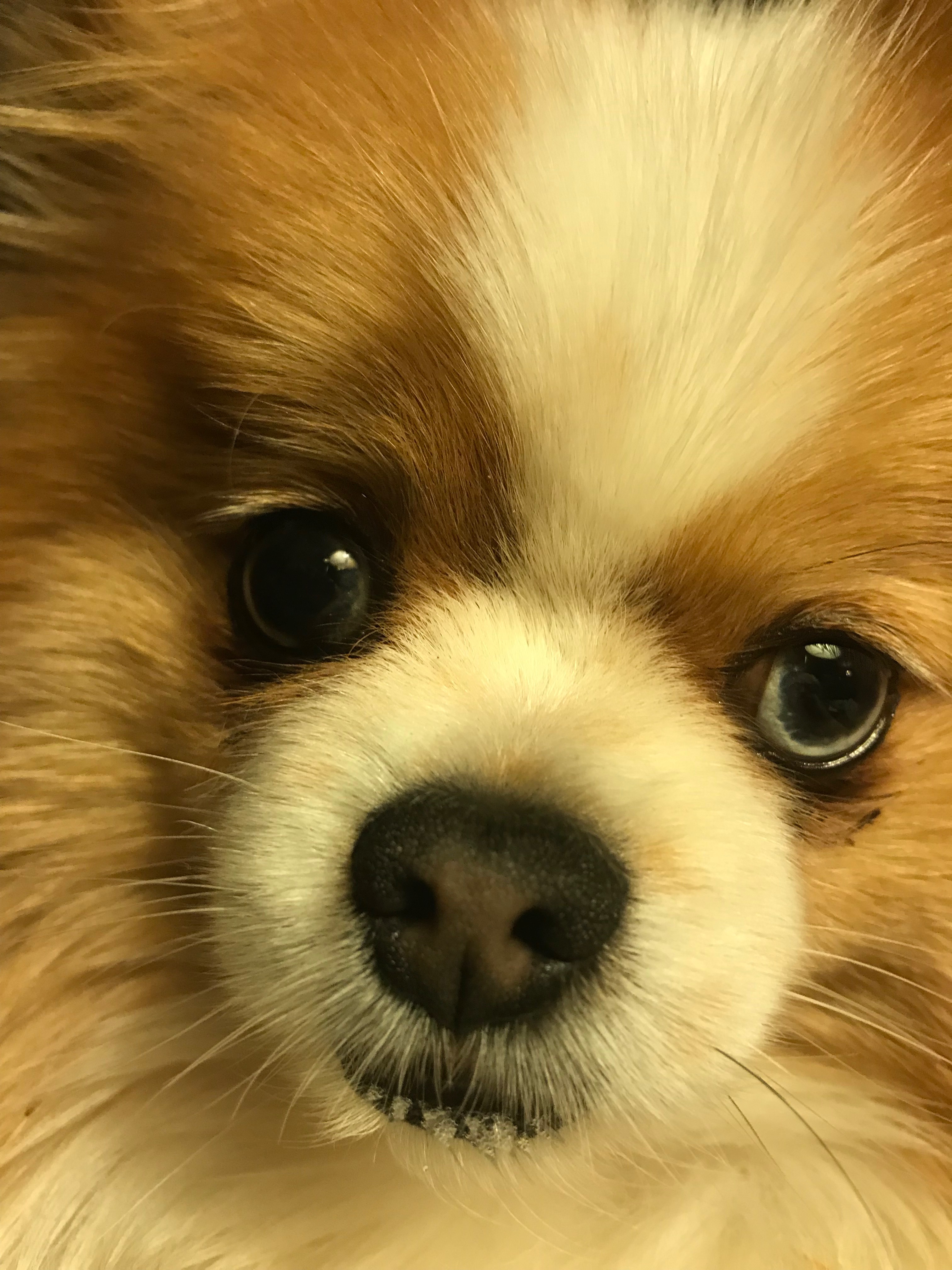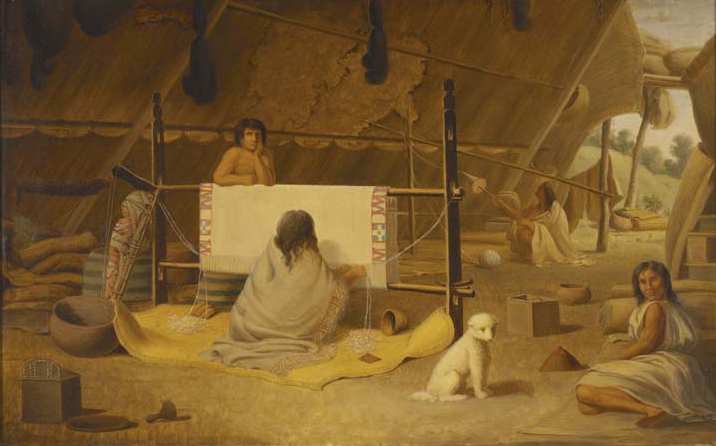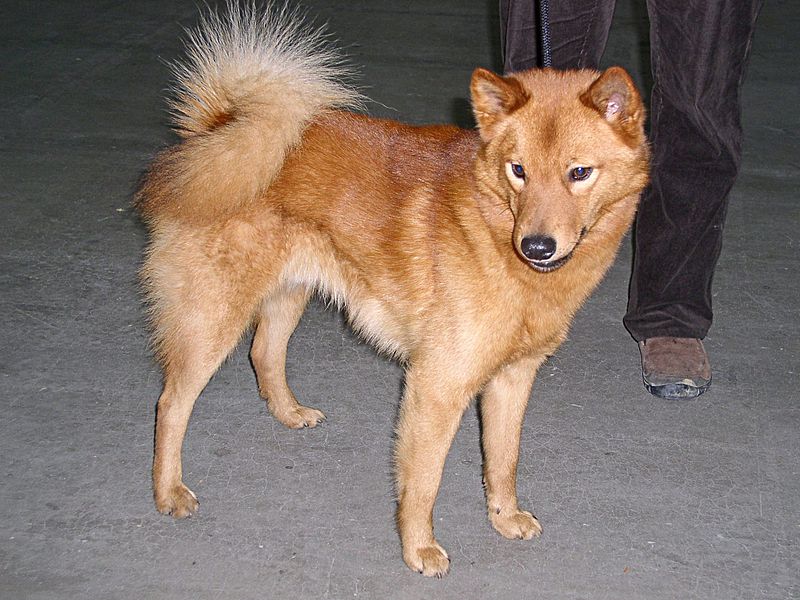It’s a fiber 8 times warmer than wool. It doesn’t shrink when washed and it doesn’t stretch. And if you own a long-haired dog, the raw material is free. Dog hair yarn! Yarn made from dog hair is toasty warm, has a lovely halo, and is growing in popularity as a niche yarn. While it has never been common, it has a long history.

Capt. George Vancouver, a British navy officer who surveyed the Pacific Northwest in 1791 – 1795, wrote of the “woolly dogs” raised by the Coast Salish peoples of the Pacific Northwest. The small, white dogs with long hair were alert and intelligent. They were specifically bred for their coats and were kept separate from the other dogs in the villages. They were fed salmon, a diet which is as beneficial for dog’s coats as it is for people’s skin. The Coast Salish cut the dogs’ hair yearly in the spring, then washed and spun the fiber for use in weaving.
Fur traders and explorers moving into the Pacific Northwest noted what warm blankets the Coast Salish wove. The dog hair, which is hollow, had a wonderful insulating effect that took the chill out of damp winter nights. The blankets were so valuable they were used as currency among the Salish peoples. For other items, the Coast Salish would combine the dog-hair fiber with mountain goat hair, which they obtained through trade with other tribes. They also utilized goose down and plant fibers to make other blends with the dog hair.
The diseases brought by outsiders and the pressures of immigration by settlers into Salish territory decimated the tribe and disrupted their culture. By 1900, traditional spinning and weaving were no longer practiced. Commercially produced wool yarn and factory-made blankets replaced dog-fiber yarn. The woolly dogs were no longer kept separate from other dogs and they became extinct as a breed.

Courtesy of Wikimedia Commons
Painter Paul Kane traveled the fur trade routes of the Hudson Bay Company in the mid-1840s, and sketched the lives of the First Nations people he met there. One of his paintings is the interior of a home of a Coast Salish family. The mother is pictured weaving a large white blanket while a furry, white dog looks at the painter. Oddly, despite a generations-old culture of using dog hair as fiber, the documentation of Vancouver and Kane’s paintings, 20th-century academics questioned the idea that dogs were bred and used as an important source of textile fiber. Since few examples of Coast Salish textiles are in museums, researchers were hesitant to test them to determine their true fiber content.
The opportunity came in 2017 when a Coast Salish blanket at the Burke Museum of Natural History and Culture in Seattle, Washington developed a tear. Liz Hammond-Kaarremaa, a Coast Salish spinning expert, was able to use the tear to better understand the construction of the blanket and to analyze the fibers used to make it. The weft thread reminded her of the hair of a taxidermy dog in the Smithsonian Institute, labeled “Salish Woolly Dog.” Microscopic analysis proved Hammond-Kaarremaa correct; woolly dog hair was indeed used to spin the weft thread. Coast Salish weavers who are working to revive traditional weaving now know without a doubt that the woolly dogs really were a source of fiber.
The Coast Salish spinners and weavers of today don’t have woolly dogs from which to harvest white hair. They closest they would be able to get are the woolly dogs’ circumpolar cousin – Finnish spitzes. The spitz, which is an excellent hunting dog, probably wasn’t ever used for its hair. The Finns had access to sheep, whose large fleeces produce more, and easier-to-process, fiber. While surely some frugal Nordic of some stripe harvested the dog hair available to her or him, dog-hair spinning did not develop as part of the culture.

Courtesy of Wikimedia Commons
Dog-hair spinning in this age is more often motivated by the desire to have a garment or accessory that is a reminder of a beloved pet. Spinner, knitter, designer, Ingebretsen’s instructor, and dog-lover Wendy J. Johnson has spun dog hair and has some advice for people who want to give it a try themselves:
Beware that it is a very static-producing fiber so you may need to very lightly spritz it with some water (consider lavender water for the aromatherapy benefits!) just before you start spinning. Don’t get it too wet though. Just a light spritz to settle down the static that will inherently come about from working with it. Some dog hair is well suiting to spinning on its own, such as Newfoundland, but shorter hair and hair with less crimp benefit from being blended with another fiber, such as wool. The wool helps to contain the shorter or more slippery dog hairs during the spin. But be aware that if you are working with short dog hair in a blend, it may “bloom” out of the yarn over time like Angora does. You may become your own shedding dog!
We are now in the season where many of us have a ready cache of shed dog hair, generously supplied by our own pets. Whether one is inspired to collect, wash, spin, and knit this gift into a garment, or not, remember that man’s best friend has yet another gift to share with us.
I worked with someone whose mother used dog hair “yarn” to make gifts. One of the recipients of these gifts was attacked by another dog while wearing the mittens she’d recieved.
Hello, I ran across this post while reading about Nalbinding.. Fascinating info about the Coast Salish wooly dogs. Sad to learn the breed disappeared when the Salish people’s lives were shattered by European diseases and introduction of non native cultures.
Probably more that 30 years ago I spun a full skein of yarn from the hair of my friend’s white Russian Wolfhound, aka Borzoi. I did not knit or crochet at the time so the yarn was handed off to a different friend who crocheted a pair of baby booties and a hat to give to the dog owner as a shower gift for her first baby. I went over to my friend’s house 3-4 times in the same week and brushed the dog without her knowing it. Ended up with a grocery bag full of white fluff. I remember it was a little slippery to spin and since I was never a great spinner, the yarn was thick and thin with an occasional big hunk of unspun fiber thrown in. Still the baby set was beautiful.
Thank you for the history lesson about the Salish fiber artists.
What a lovely gift for your friend! Secretly grooming the dog was a gift, too.
You are now one of the few people in the modern world who understands how difficult it is to spin dog hair and can fully appreciate the Salish people’s textile skills.
So glad you enjoyed the post.